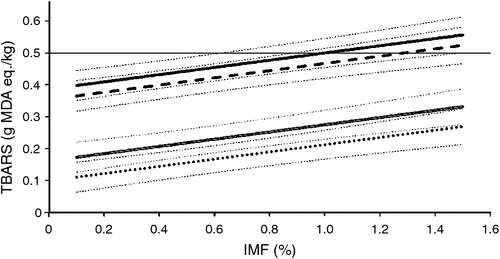Vitamin E does not counteract the shortened shelf life of long-stored pork with increasing levels of intramuscular fat
C. G. Jose A C and J. C. Kim BA Murdoch University, Murdoch, WA 6150.
B Department of Agriculture and Food, South Perth, WA 6151.
C Corresponding author. Email: c.jose@murdoch.edu.au
Animal Production Science 55(12) 1467-1467 https://doi.org/10.1071/ANv55n12Ab106
Published: 11 November 2015
The extended storage of red meat products increases lipid oxidation, particularly in high intramuscular fat (IMF) meat (Calnan et al. 2014). This decreases retail shelf life, an effect that is minimised in sheep by dietary supplementation with vitamin E (VE; Jose et al. 2008). However this has not been tested in long-stored (>14 d) Australian pork. The hypothesis examined herein was that supplementing finisher pigs with VE would enable extended storage of pork without an associated increase in spoilage during retail display.
Thirty two female Landrace × Large White pigs (49.3 ± 0.15 kg, mean ± SD) were housed in individual pens and fed a diet supplemented with either 35, 300, 500 or 700 IU of VE (α-tocopherol acetate) for 6 weeks (n = 8). The pigs were slaughtered at an average live weight of 86.6 ± 1.21 kg. A sample of the m.longissimus thoracis et lumborum (loin) was removed from the carcass 24 h after slaughter, divided into two and allocated to one of three aging treatments (0, 14 and 28 days), vacuum packed and stored at 4 °C for the corresponding period of time. The muscle was then cut into steaks 2.5 cm thick, overwrapped and set for retail display under florescent lights at 4 °C. A 5 g sample was removed from each steak at 0, 2, 4 and 6 d of retail display to measure the thiobarbituric acid reactive substances (TBARS). A TBARS number greater than 0.5 mg of malondialdehyde equivalents (MDA eq.)/kg is an indication of off-flavour development (Lanari et al. 1995). Both IMF and VE content in the muscle were measured and were used as continuous variables to test the development of TBARS during retail display at different aging treatments. Data were analysed using a linear mixed effects model (SAS®; USA).
Loin VE content increased with increasing supplementation (P < 0.05), with values ranging from 2.59 to 8.06 mg/kg (mean of 5.06 ± 0.24 mg/kg). The TBARS increased with days on retail display (P < 0.001) and at a greater rate in long-stored product. Increasing VE content decreased the TBARS concentration in the 0 d-stored product by 0.02 g MDA eq./kg for every 1 mg/kg of VE in the muscle (P < 0.001). However there was no effect (P > 0.05) in the meat stored for 28 d, contrary to the hypothesis. The apparent ineffectiveness of VE may be due to a lack of range in muscle VE concentrations, particularly at the lower end of the scale. In this regard, Jose et al. (2008) improved shelf-life in lamb up to a maximum muscle VE concentration of 3.5 mg/kg, a level exceeded with all supplementation rates used in this experiment. There was no effect of increasing IMF concentration on TBARS in 0 d-stored product, however an increase of 1% IMF increased the production of TBARS by 0.085 and 0.12 g MDA eq./kg for the 14 d- and 28 d-stored product, respectively (Fig. 1). This was despite a small range in IMF content (0.1 to 1.9%; mean = 0.61 ± 0.19%). Under long-stored conditions, the high-IMF pork had reached the off-flavour threshold after 4 d of retail display (Fig. 1). Thus, IMF appears to be an important factor limiting the shelf life of long-stored pork.

|
References
Calnan HB, Jacob RH, Pethick DW, Gardner GE (2014) Meat Science 96, 1049–1057.| Crossref | GoogleScholarGoogle Scholar |
Jose CG, Gardner GE, Pethick DW, Jacob RH (2008) International Congress of Meat Science & Technology 54 , 149, eds LC Hoffman, EC Webb, D Lister, E Puolanne, A Hugo, K McMillin, PE Strydom.
Lanari MC, Schaefer DM, Scheller KK (1995) Meat Science 41, 237–250.
| Crossref | GoogleScholarGoogle Scholar |
This work was funded by the Western Australian Agricultural Produce Commission and Pork CRC Limited Australia.


 Day 0
Day 0  Day 2
Day 2  Day 4
Day 4  Day 6) (±SEM, as thin dashed lines). The horizontal line at 0.5 is the TBARS threshold, indicating off flavour development.
Day 6) (±SEM, as thin dashed lines). The horizontal line at 0.5 is the TBARS threshold, indicating off flavour development.